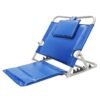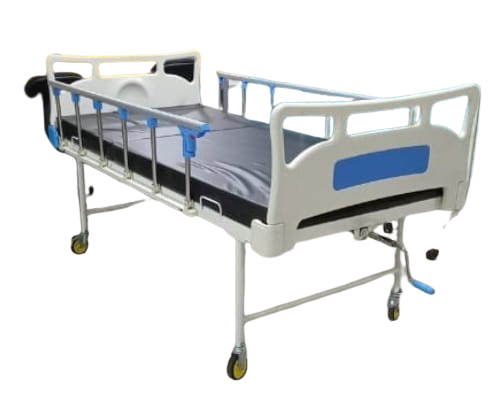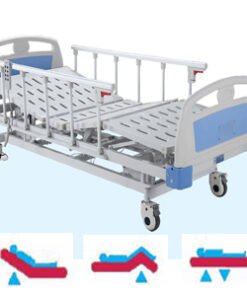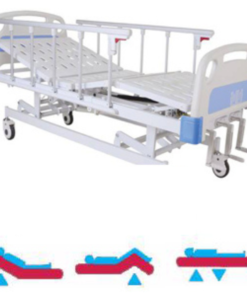Starting From: ₹2,500.00
Request a demo Call 844-844-0648
Experience optimal patient care with our Hospital Bed—adaptable, secure, and designed for comfort. Featuring adjustable positions, intuitive controls, and safety features, it ensures a seamless healthcare experience
SKU: N/A
Category: Hospital Bed on Rent
Tags: Adjustable Bed, Bariatric bed, Bed rail, Elderly care bed, Electric bed, Folding bed, Home Care Bed, Hospital crib, Hospital mattress, ICU bed, Intensive care unit bed, Long-term care bed, Low bed, Maternity bed, Medical bed, Mental health bed, Orthopedic bed, Palliative care bed, Patient bed, Pediatric bed, Pressure relief bed, Rehabilitation bed, Siderail bed, Transfer bed, Wheelchair bed
Introducing the innovative Hospital Bed – the ultimate solution for patients in need of comfort, care, and superior quality. This versatile bed integrates cutting-edge technology with a wide range of essential features to ensure optimal well-being.
Equipped with a highly advanced hospital mattress, this bed guarantees unparalleled comfort and support for patients of all ages and medical conditions. Its adjustable bed functionality allows for effortless customization, catering to individual needs and preferences. No matter the requirement, this bed can be effortlessly transformed to accommodate patients’ comfort levels with ease.
Safety is paramount, which is why this bed comes with sturdy bed rails to prevent any accidental falls or injuries. In addition, the electric bed option enables seamless adjustments for patients with limited mobility, granting them greater independence and freedom within the hospital environment.
Tailored specifically for medical facilities, such as ICUs and rehabilitation centers, the hospital bed provides a reliable and efficient medical solution for specialized care. Its ICU bed capabilities are specially designed to meet the unique demands of intensive care units, guaranteeing optimal comfort and support for critical patients.
This exceptional bed is not just limited to hospital settings; it extends its functionality to home care as well. With its versatile features, it seamlessly transforms into a wheelchair bed, allowing patients to move between different areas effortlessly. Additionally, the bariatric bed option caters to patients with mobility challenges, accommodating their needs with utmost care and comfort.
Designed with convenience in mind, the folding bed functionality ensures easy storage and transportability, making it ideal for patients on the move. Its low bed feature provides extra safety for patients prone to falling, granting peace of mind to both patients and caregivers.
Catering to all life stages, our pediatric bed guarantees the utmost care and support for children. With their unique needs in mind, this bed ensures their comfort during hospital stays, enabling a faster recovery process.
It’s not just about physical well-being; mental health is equally important. The mental health bed option incorporates thoughtful design elements to create a soothing and calming environment for patients undergoing treatment for psychiatric conditions.
Long-term care calls for specialized attention, and our hospital bed rises to the occasion, providing utmost comfort for extended periods. Additionally, the palliative care bed feature comprises elements that alleviate discomfort, providing solace and relief during challenging times.
Not forgetting our littlest patients, our hospital crib offers a safe and comfortable sanctuary for newborns and infants, ensuring a nurturing environment for their growth and development.
With the siderail bed option, patients can experience optimal safety without compromising comfort. These secure and easy-to-use siderails bring peace of mind to both patients and caregivers.
Caring for our elderly population requires extraordinary beds, and our elderly care bed option delivers exceptional care and support for seniors. Designed to address their unique needs, this bed ensures comfort, safety, and mobility.
Welcome to the future of healthcare with our exceptional hospital bed. Experience unmatched comfort, safety, and flexibility in one remarkable product. Embrace the ultimate care companion for patients across various medical conditions and settings. Try it today and unlock a new dimension of care and comfort!
Q: What is a hospital bed?
A: A hospital bed refers to a specially designed bed used in medical facilities to provide comfort, safety, and appropriate care to patients in various healthcare settings.
Q: What are the types of hospital beds available?
A: There is a wide range of hospital beds available, including adjustable beds, electric beds, ICU beds, patient beds, wheelchair beds, bariatric beds, folding beds, low beds, pediatric beds, home care beds, rehabilitation beds, orthopedic beds, pressure relief beds, transfer beds, maternity beds, mental health beds, long-term care beds, palliative care beds, hospital cribs, siderail beds, and elderly care beds.
Q: How are hospital beds different from regular beds?
A: Hospital beds are designed with features that are not typically found in regular beds. These features include adjustable height, head, and foot position, siderails, detachable mattresses, and the ability to accommodate various medical devices.
Q: What is an adjustable bed?
A: An adjustable bed is a type of hospital bed that allows patients to change the position of their head and feet, providing maximum comfort and support. This feature is particularly useful for patients with medical conditions like acid reflux, respiratory difficulties, or back pain.
Q: What is a bed rail?
A: A bed rail is a safety feature often found on hospital beds. It is a metal or plastic barrier attached to the sides of the bed to prevent patients from falling or rolling off the bed during sleep or while moving.
Q: How do electric beds work?
A: Electric beds are equipped with a motorized system that allows patients or caregivers to adjust the height, head, and foot position of the bed with just a push of a button. This feature allows for easy and convenient adjustments without manually cranking or lifting.
Q: What can you tell me about ICU beds?
A: ICU beds, also known as intensive care unit beds, are specifically designed to meet the needs of critically ill patients. They often have advanced features like built-in CPR mechanisms, electronic controls, and pressure redistribution surfaces to cater to the unique requirements of patients in intensive care.
Q: What is a bariatric bed?
A: A bariatric bed is designed to safely accommodate and support larger or obese patients. These beds have a higher weight capacity and wider dimensions than regular hospital beds to ensure proper patient care and comfort.
Q: What is the purpose of a folding bed?
A: A folding bed is a space-saving option that can be easily folded and stored when not in use. It is commonly used for temporary patient care needs or as an extra bed for visitors.
Q: What is a low bed?
A: A low bed is a hospital bed set at a lower height than regular beds, reducing the risk of fall-related injuries for patients with mobility issues or those who are at risk of falls.
Q: What is the significance of a pediatric bed?
A: Pediatric beds are designed to meet the unique needs of children in healthcare facilities. They often include features such as safety rails, colorful designs, and smaller dimensions, ensuring a safe and comfortable environment for pediatric patients.
Q: How are orthopedic beds different from regular beds?
A: Orthopedic beds are specifically designed to provide optimal support to patients with orthopedic conditions like arthritis, back pain, or fractures. These beds often have pressure relief features and specialized mattresses to alleviate pressure on the joints and promote proper alignment.
Q: What is a pressure relief bed?
A: Pressure relief beds, also known as anti-decubitus beds, are designed to prevent pressure ulcers or bedsores by continuously redistributing pressure and reducing friction on the patient’s skin. These beds are especially beneficial for patients with limited mobility or those who spend extended periods in bed.
Q: How is a maternity bed different from a regular bed?
A: Maternity beds are designed to support pregnant women before, during, and after childbirth. These beds often have adjustable features, specialized support surfaces, and convenient access for medical procedures related to labor and delivery.
Q: What is the purpose of a mental health bed?
A: Mental health beds provide a safe and secure environment for patients with mental health conditions. These beds often have anti-ligature features, enhanced behavioral controls, and a calming color scheme to ensure patient safety and comfort.
Q: Are there beds available for long-term care?
A: Yes, long-term care beds provide comfort and support for patients requiring extended stays in healthcare settings. These beds often have features such as pressure relief surfaces, easy repositioning, and enhanced durability to meet the unique needs of long-term care patients.
Q: What is the role of a palliative care bed?
A: Palliative care beds are designed to provide comfort and dignity to patients with terminal illnesses or conditions. These beds often prioritize pain management, positioning, and ease of use for both patients and caregivers during end-of-life care.
Be the first to review “Manual Hospital Bed on Rent” Cancel reply
Related products
Product added!
Browse Wishlist
The product is already in the wishlist!
Browse Wishlist
Hospital Bed on Rent
Starting From: ₹7,500.00
Product added!
Browse Wishlist
The product is already in the wishlist!
Browse Wishlist
Hospital Bed on Rent
Starting From: ₹6,000.00
Product added!
Browse Wishlist
The product is already in the wishlist!
Browse Wishlist
Hospital Bed on Rent
Starting From: ₹2,000.00
Product added!
Browse Wishlist
The product is already in the wishlist!
Browse Wishlist
Hospital Bed on Rent
Starting From: ₹2,500.00
Product added!
Browse Wishlist
The product is already in the wishlist!
Browse Wishlist
Hospital Bed on Rent
Starting From: ₹4,500.00









Reviews
There are no reviews yet.